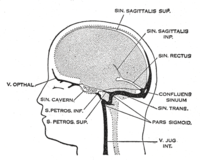
Photo from wikipedia
Clonal proliferation of hematopoietic precursors leading to progressive expansion of myeloid cells with a predominant increase of red cells characterizes the hematological phenotype of Polycythemia Vera (PV). The resulting blood… Click to show full abstract
Clonal proliferation of hematopoietic precursors leading to progressive expansion of myeloid cells with a predominant increase of red cells characterizes the hematological phenotype of Polycythemia Vera (PV). The resulting blood hyperviscosity is a major determinant of vascular complications which severely impact on morbidity and mortality of these patients. Aggressive maintenance of a target hematocrit level lower than 45% with phlebotomy (PHL), either alone or associated with cytoreductive drugs, and low-dose aspirin have been shown to reduce the thrombosis rate in the randomized controlled CYTO-PV and European Collaborative Lowdose Aspirin Polycythemia Vera (ECLAP) clinical trials, respectively, and are recommended therapies in the clinical practice. In patients at high-risk because of age and/or history of thrombosis, hydroxyurea (HU) is the recommended frontline cytoreductive drug based on a small observational study (PVSG protocol 08), in which 51 HU-treated patients experienced a lower incidence of thrombosis compared with historical controls managed with PHL. More recently, interferon (IFN)-α and ruxolitinib (a JAK1 and JAK2 inhibitor) have been introduced into the therapeutic armamentarium for patients with PV, yet in the absence of controlled evidence of superiority over HU as regards prevention of thrombosis, and a relative lack of information about safety over long-term use for ruxolitinib. The recommendation that HU should be a first line therapy has been criticized since no solid demonstration of its efficacy to prevent thrombosis or prolong survival has been produced so far. Moreover, the concern that HU may increase the risk of leukemic transformation led to suggest therapeutic PHL as the only first line therapy, irrespective of patient risk category. Recently, we documented an advantage of HU over PHL in a cohort of 1042 patients with PV included in the ECLAP trial consistently significant with respect to the proportion of fatal/nonfatal CV events (13.2% vs. 7.9% in PHL vs. HU groups, respectively, p= 0.006) and myelofibrosis transformation, that was more frequent in patients treated with PHL only. In the present work we investigated more thoroughly the same cohort of PV patients to determine whether cytoreduction therapy with HU, in comparison with therapeutic PHL, was differently effective in protecting from arterial and venous thrombosis. The rationale of this analysis, approved by our IRB, is supported by the following considerations: (i) the two vascular complications are biologically different processes with distinct physiopathology supporting that arterial and venous events are separate entities with specific risk factors that require careful evaluation and management. (ii) HU may predominantly exert its antithrombotic property by reducing the cellular components of thrombi formation, including leukocytes, and (iii) leukocytosis is associated more with arterial than venous thrombosis in PV. We selected patients who, during the follow-up, had received only PHL or HU to maintain the HCT level < 45%. To assure comparability, we conducted a 1:2 Propensity Score (PS) matching analysis by forming matched sets of 1 PHL and up to 2 randomly sampled
Journal Title: Blood Cancer Journal
Year Published: 2018
Link to full text (if available)
Share on Social Media: Sign Up to like & get
recommendations!